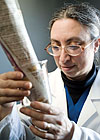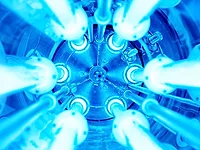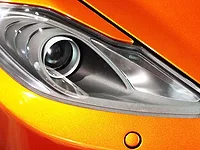Nano-Sanity: A Solution to the Coatings Dilemma

Albert Einstein defined insanity as doing the same thing over and over again and expecting different results. In these times of spiraling energy costs and increasing environmental concerns, that definition might be stretched to include using the same coating techniques and expecting superior results.
Despite the pressure of environmental, regulatory and efficiency demands, the coatings industry has been slow to embrace the new generation of coating technologies. For example, 100%-solids UV-curable coatings provide the inherent advantages of reduced production time as well as a decrease in the release of polluting emissions and hazardous waste. A smaller footprint enables plants to be smaller. Durability in the final product may also increase. To date, these potential improvements have not been enough to overcome the inertia of the manufacturing community and promote change. Today’s high energy prices, in combination with the improved performance made possible by the addition of nanoparticles, may be the push needed to get the coatings industry and its customers over the hump.
Most conventional coatings require a considerable energy investment to achieve cure. Even the newest of surface finishing techniques in common use today, powder coating, requires raising the temperature of large masses of metal for more than 20 minutes at a time, a very energy-intensive undertaking whether it is accomplished through IR radiation or natural gas-fired ovens. When conventional liquid coatings are used, those same processes must be used to drive off carriers, either organic solvents or water.
Waterborne coatings can be air-dried. In the case of air-drying, costs show up as increased production time, as well as greater space and ventilation requirements. Performance may also be an issue with waterbornes. Such coatings can cause flash rusting. Hardness, abrasion resistance, corrosion resistance and adhesion are often below the levels seen for either conventional liquid coatings or for powders.
In contrast, 100%-solids UV-curable coatings cure very quickly, usually in seconds. This rapid cure may result in energy savings of up to 75%. When these savings are combined with faster production, reduced space requirements and environmental advantages, such coatings become an attractive alternative to other current technologies.
Nanotechnology Advantages
With energy savings paving the way, nanotechnology has come to the scene to help produce a set of properties that make UV-curable 100%-solids coatings even more attractive. Coating qualities include improved flow characteristics, reduced thinning on sharp edges and an even appearance. Nanoparticles can also increase the hiding power of these coatings by a factor of 20%.Matte Coatings
One of the more interesting applications of nanoparticles is in matte coatings, a particular challenge in the 100%-solids market. Most matting agents substantially increase viscosity, a problem that is usually addressed by the addition of either organic thinners or water. This solution can’t be used in a 100%-solids formulation. Some monomers may be added as reactive diluents, but their addition significantly affects the properties of coatings. Through a proprietary method, Ecology Coatings disperses amorphous nanoparticles in a variety of monomer components to produce a family of additives for the formulation of matte coatings with nearly zero increase in viscosity.
Nano-Enabled Barriers
Nanoparticles may be used to create barriers to air, water and other vapors, and various solvents. Such barriers work by filling space. A combination of nanoparticles and larger-sized particles is particularly effective for this purpose. By adjusting the percentage of particles or the application of coating itself, the barriers may be fine-tuned to specifically block water, air or solvents. Because these coatings do not work through hydrophobicity, this technique produces surfaces that may be printable and overcoatable.Nano-enabled moisture barriers are particularly useful as a tool against microorganisms that thrive in a moist environment. This is particularly an issue in the case of flooding. Even a few inches of water may be very damaging when absorbed by drywall. When water is absorbed by drywall, spores landing on the paper surface of the drywall access the moisture and grow quickly. Sealing a porous surface blocks access to water and thus limits growth. A coating that acts against microbes in multiple pathways may be even more effective in that it is less likely to fall victim to resistant organisms. For example, the addition of a combination of nanoparticle antimicrobials that break down cell walls along with larger particle additives (such as mixtures of silver and copper) may create a more effective coating for combating organism growth.
While many organisms may flourish in the presence of moisture, many electronic displays find it fatal. Conventionally, this problem is solved by using glass to protect sensitive components. However, glass has drawbacks; namely it is breakable, heavy and inflexible. Alternatives such as polycarbonate may absorb water. Serving as air and vapor barriers, coatings with nanoparticles can be used as a direct replacement to glass for more porous materials. In testing done in accord with ASTM D 3985-02, an Ecology Coatings product lowered air permeance 6-200 times depending on the thickness of the coating used.
In addition to serving as a direct barrier, coatings can enable other protective barriers. Although plastics like polycarbonate are lighter and more flexible than glass, their use as a replacement has been limited by a propensity for scratching and vulnerability to common solvents. Enabled by nanoparticles that maintain clarity and unprecedented hardness, Ecology Coatings’ polycarbonate product addresses both of these issues.
Looking Forward
While industry may find many advantages in the use of a new generation of coatings, our interests will be best served by paying close attention to potential health and environmental concerns associated with new technologies. Since much is yet to be learned, it would be wise to err on the side of caution by using the strictest of industrial hygiene practices. Since the advent of clean air and water regulations in the United States, the finishing industry has managed and mitigated these types of health issues. Tools to minimize both particulate exposure and release are already in place to manage potential risks. Now is the time to continue and expand the use of that toolset as we move forward. While current studies seem to indicate that respiratory equipment for the control of particulate exposure may be effective with nanoparticles as well, further study and vigilance will help to prevent injury and reduce future liability.As we look towards the future, we look forward to a better understanding of coating materials and continued improvements to the technology. Use of 100%-solids UV-curable coatings with nanoparticles can enable more energy efficient manufacture. Use of lighter materials made durable by coatings will result in fuel savings for consumers and end-users. Improvements in the control and confinement of air, water and solvents may help in the construction of devices and infrastructure for alternative energy sources. Driven by energy volatility and enabled by nanomaterials, we are approaching the tipping point for a move toward the superior products required to meet our voracious energy demands.
For further information see www.ecologycoatings.com or email sally@ecologycoatings.com.
Looking for a reprint of this article?
From high-res PDFs to custom plaques, order your copy today!







